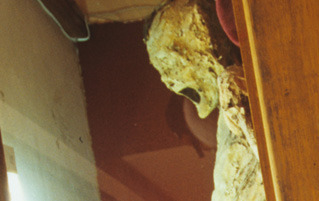Hitler's Super Jet: 6 Lost Historical Secrets We've Dug Up

Historians look at the past like a 6-year-old looks at a crusty scab -- they aren't happy until they've picked it over and there's blood everywhere. If given the technology and enough money, yes, some overly curious scientist will clone Hitler. And they'll probably clone him just to find out the answer to a stupid question, like: "Which sock did he put on first in the morning?" For instance:
Scientists Mummify A (Modern) Human Leg
Thanks to years of pop culture indoctrination, we all know the basics of how to create a mummy: Remove the brain through the nose, wrap the body in bandages, read from the Book Of The Dead, prepare for the horde of unspeakable evil that you've released on the planet -- that sort of thing. However, we still don't know what the mummification process looks like. Or, at least, we didn't until recently.
After raiding the nearest mortuary and stealing the corporeal legs of what is now the world's most pissed-off/disgusted ghost, a team of scientists from the University Of Zurich subjected each leg to a different method of mummification. The first was soaked in natron, a type of soda ash found on several mummies, while the second was subjected to "dry heat" (essentially, the same drying process that your jerky goes through).
Although the latter experiment had to be stopped after only a few days due to an "unexpected lack of mummification" (here taken to mean, "It started to rot"), the natron experiment eventually yielded what the scientists had been looking for: a completely mummified leg, as well as an unexpected opportunity to discover what it's like to never sleep again.
They could never listen to ZZ Top the same way again.
Along with a blow-by-blow photographic record of what the mummification process looks like, the experiment concluded that the speed at which human remains mummify depends on factors such as temperature, humidity, and acidity. They even noted that the experiment would have finished quicker if it had been done in a desert environment. However, their bosses presumably pointed out that they'd already flirted with a horror-movie-esque death by creating their own mummy, and doing so in Egypt might have tempted the gods into unleashing some righteous karmic justice.
Scientists Study Ancient Plague (By Resurrecting It)

Whenever a movie character discovers an ancient plague, it always, always ends up killing them. Of course, that's complete fiction. You can't just dig up an ancient virus and be bleeding from your eyeballs minutes later. No, if you wanted to reanimate an ancient killer germ, you'd need to take it to a laboratory, have a group of scientists re-engineer its remains, and decode its genetic sequence. But only a crazy person would do that, right?
Right?
Right.
Well, ask the scientists who decided to reconstruct a mysterious plague that ravaged the world in the year 541 and killed as many as 50 million people (by comparison, the Black Death killed between 75 million and 200 million). As well as providing fodder for at least several Tom Clancy novels, they were interested in the exact nature of the disease, as well as any details about where it originated, presumably so part of the planet could be carpet-bombed to prevent a recurrence ... just in case.
After probing and removing blood samples from several teeth found in a plague mass grave, the scientists were able to recover a fragment of the virus. Using the same technology presumably used in Jurassic Park to re-create other historic killers, they were able to decipher the virus' genetic sequence and ... voila, another goddamn thing that could kill us.
According to their findings, the virus emerged somewhere in China and, just like the Black Death, was spread by rats, nature's genocidal terrorists. As for the threat posed by the plague, it turns out that we were worried for nothing, because, according to one of the scientists, the only thing preventing another outbreak is modern medicine.

Researchers Re-Create An Ancient Cure For MRSA (From An Old Textbook)

If you've been keeping up with our multi-part series about how some old-timey medicine was just as advanced as medicine is today, you'll understand why scientists love trying out recipes that they find in historic textbooks. At worst, they've ruined several hundred dollars of lab equipment -- at best, they might discover the elixir of life.
Case in point: the millennia-old recipe that turned out to be capable of killing the modern-day superbug MRSA (Methicillin-resistant Staphylococcus aureus, for the medical nerds out there).
These assholes.
It all began after the wacky future-sitcom pairing of Freya Harrison, a microbiologist, and Christina Lee, a historian, who tried their hand at experimenting with a recipe from the Anglo-Saxon medical textbook Bald's Leechbook, which as of this writing isn't available in an eBook format. After gathering the necessary ingredients (and trying to find those that most closely matched their historic counterparts), they created their brew and let it stand for the nine days dictated by the recipe (which we can't help but read with a witchy tone of voice).
Testing their concoction on several scraps of MRSA-infected skin, they found that it killed 90 percent of the bacteria, making it equally as strong as the modern-day antibiotic currently used to treat the disease. Does this mean that your next hospital visit is going to include a swig of ancient cauldron juice under the full moon while witches invoke Satan to cure your infection? Probably not, but don't freak out if nurses start walking around in pointy black hats.
Archaeologists Re-Create Stone-Age Glue

With an arsenal ranging from axes to scrapers and stone blades to atlatl, our prehistoric ancestors were more than capable of fending off anything that threw some shade their way (you know, except cannibalistic cavemen). However, one mystery puzzled archaeologists for years: What are the red stains covering preserved wooden ax handles? Evidence of a ritual? A by-product of day-to-day use? Dinosaur blood?
As it turns out, it was a type of glue that held the head-crushing stones to their wooden handles. And we only know this because a group of archaeologists spent a ton of research money living their dream of building prehistoric weapons and smacking the living shit out of stuff with them.
Originally, they thought that prehistoric weapons were held together using a glue made from the gum of the acacia tree. However, tests showed that glue was ridiculously easy to shatter, an understandably poor quality for any weapon that you're planning to ram into someone's head, much less be swinging above yours. When they combined the acacia gum with red ochre powder, it made the glue more resilient to shocks, resulting in less shattering and -- give or take several millennia buried in the ground -- that distinctive red staining.
This also suggests that our ancestors were more advanced with chemistry than we thought. In making the glue, they would have had to account for the unique properties and chemical compositions of each acacia tree and red ochre deposit, a process that would have involved a dinosaur shit-ton of experimentation. The only question left is: How many thousands of years of glue-sniffing did it take before someone realized metal weapons might be a little more effective than stone ones?
Researchers Test Efficiency Of Ancient Obsidian Knives (By Performing Surgery With Them)
You might think that, thanks to that glue, stone tools are the cutting edge of prehistoric weaponry. However, they don't even come close to the devastating awesomeness of obsidian knives -- blades made of a glass-like rock that outclasses steel, razor blades, and diamonds in every single way relating to sharpness. If God could bleed, this would be the blade that could do it.
Use it for the closest shave of your life. And the last.
In experiments that used obsidian knives for animal surgery, scientists discovered that the ultra-sharpness of obsidian allowed medical incisions to heal faster and neater than they otherwise would have with standard steel scalpels. This is actually quite fortunate for two reasons: First, prehistoric "doctors" used obsidian knives during trepanation surgeries (which involve cutting a hole through the skull), and second, because crazy scientists have been using them in real-life surgeries since 1975 ... surgeries that were carried out on themselves.
As this rundown demonstrates, obsidian blades have been used for everything from removing melanomas to reconstructive hand surgery to fucking open-heart operations. On each occasion, they prepared their own obsidian blade and requested that the doctor use that instead of the tools that they trained with, presumably because either they wanted to up the difficulty level or they were involved in some convoluted medical-negligence compensation scam.
"A lot of cocaine."
Surprisingly, no one died from these quite literal archaeological excavations (of vital organs), and, in fact, one doctor now exclusively uses obsidian blades in his surgery instead of bullshit steel scalpels.
Engineers Rebuild Hitler's Stealth Bomber (To See How Badly It Would Have Kicked Our Asses)
As part of his late-war strategy of being super fucking insane, Hitler commissioned the development of the Horten Ho 2-29 -- a super-fast bomber allegedly capable of penetrating our radar defenses and wreaking untold havoc. But note the word "allegedly." Due to the fact that they were having their asses kicked back across every inch of Europe, the 2-29 never entered full-scale production.
But in 2009, a group of engineers -- aided by a surviving set of blueprints and a handful of half-finished prototypes -- set about re-creating the plane (using era-authentic materials) in order to subject it to a series of tests and finally establish, once and for all, whether it was truly capable of dispensing bomb-shaped revenge on the good guys.
The answer: Oh shit.
After construction, the replica was mounted on a plinth and bombarded with the same radar system used by the British at the time. The results weren't good. Whereas radar was capable of picking up a standard enemy bomber at a distance of 100 miles, the stealth features of the 2-29 would have allowed it to get within 80 miles before being detected. That might not sound like much, but, combined with the 2-29's top speed of 600 mph, it would have reached the mainland eight minutes after initial detection (compared with almost 20 minutes for incoming conventional WWII bombers), way before the guys manning the anti-aircraft guns would have had time to finish their cups of tea and their crumpets.

It wouldn't have been a perfect bomber, though. The 2-29's sleek all-wing design, combined with the rough ride provided by early-era jet engines, meant that concepts such as "accuracy" and "hitting the right country" would have been purely hypothetical. This, combined with the fact that it could hold only two bombs, doesn't exactly suggest a future where we're all dressed in lederhosen and reciting Mein Kampf. But, you never know. We used to think that Nazi stealth bombers were only a plot device from Captain America. Just wait until we discover the plans for RoboHitler.

"Part monster. Part machine. All Fuhrer."
Be sure to follow us on Facebook and YouTube, where you can catch all our video content, such as Why Thomas Edison Was History's Biggest Dick and other videos you won't see on the site!
Also check out 6 Historical Heroes Who Did Awful Things Nobody Talks About and The 6 Most Embarrassing Historical Artifacts Ever Discovered.
















